MARIANI’S
Virtual Gourmet
March 19,
2017
NEWSLETTER

by Leslie Saalberg
❖❖❖
IN THIS ISSUE
BUDAPEST
Part One
By John Mariani
NEW YORK CORNER
KORALI ESTIATORIO
By John Mariani
NOTES FROM THE WINE CELLAR
THE RISE OF ROMAN WINES
Part One
By John A. Curtas
❖❖❖
BUDAPEST
Part One
By John Mariani
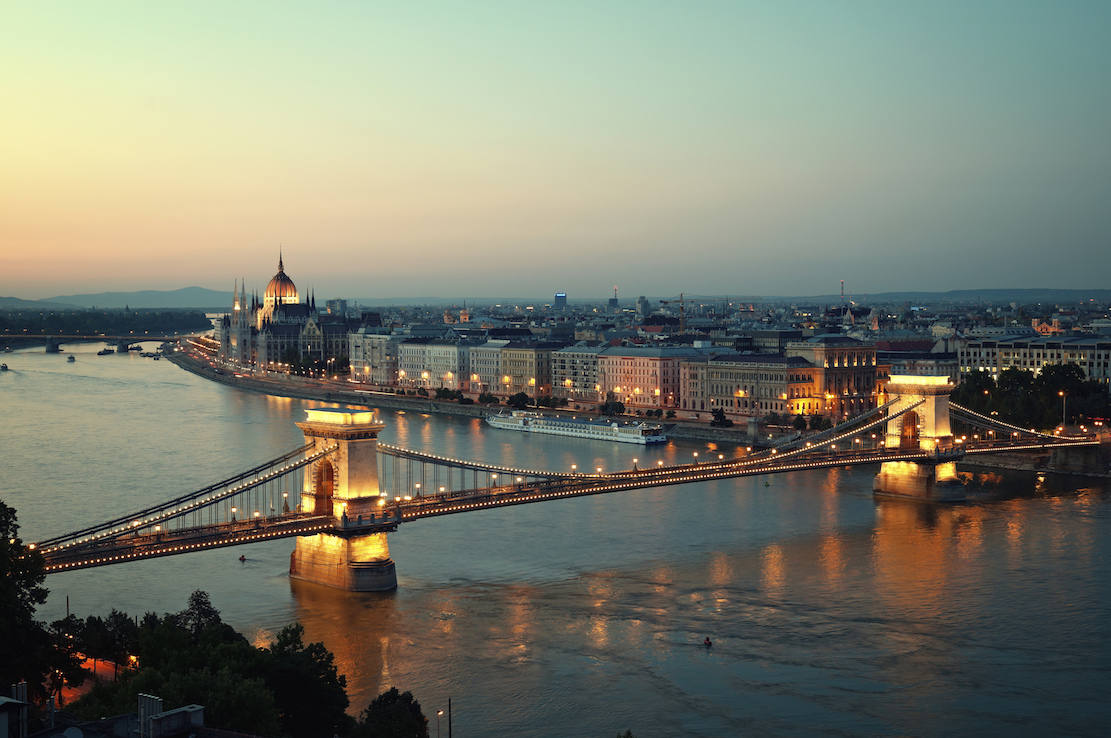
When I first visited Budapest
seventeen years ago, a decade after the Soviets
rolled out of Hungary, the city was still in the
grip of a post-war drabness that masked its
historic grandeur. The one good hotel’s only
questionable pretense to civility was that it
banned hookers from the rooms. Most
restaurants served 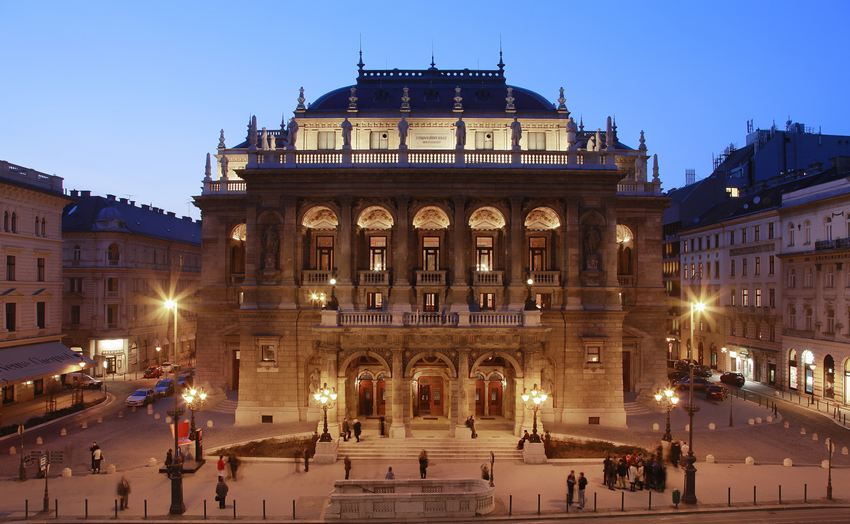 the same menu of heavy
Hungarian food without access to good
ingredients. Budapest simply wasn’t ready for
prime time tourism.
the same menu of heavy
Hungarian food without access to good
ingredients. Budapest simply wasn’t ready for
prime time tourism.
But what a difference the
Soviets’ leaving has had on this glorious European
capital! Entrepreneurs
moved in to bolster the tourist industry,
restoring the antique buildings and museums in the
Castle area, global hotel chains opened outposts,
and restaurants blossomed everywhere.
Indeed, on my trip this winter
I found Budapest now to rank with the most
beautiful and sophisticated cities in Europe, not
least for its use of public lighting that
brightens all that was once dark, from the grand
Opera House (right),
now being modernized and enlarged, on the
broad Andrássy út and the majestic Parliament on Kossuth
Square to the churches and shops along tiny
streets and avenues leading to the romantic Danube
River, which has never looked blue-er, plied
by tour boats, its banks lined with promenades and
street car lanes.
The city’s great-again architecture
reflects the once unquestioned power and wealth of
the Austro-Hungarian Empire, after the city of
Buda was combined with Pest in 1873.
 The Castle area, on
the Buda side, (reached by funicular, footpath or,
the best way, bus) is compact and far more quaint
than Pest, and it is a joy to walk the narrow
streets after wandering the vast halls of the
Hungarian National Gallery (left), which
not too long ago seemed filled with little but
huge paintings of Hungarian armies beating back
the Turkish invaders. Today, it has emerged as one
of the world’s finest museums, and, with further
reconfiguring to come, it will be even more
inclusive of art from every century and prove that
the Hungarian artists of the 19th and 20th
centuries both absorbed and manifested the leading
movements of their time.
The Castle area, on
the Buda side, (reached by funicular, footpath or,
the best way, bus) is compact and far more quaint
than Pest, and it is a joy to walk the narrow
streets after wandering the vast halls of the
Hungarian National Gallery (left), which
not too long ago seemed filled with little but
huge paintings of Hungarian armies beating back
the Turkish invaders. Today, it has emerged as one
of the world’s finest museums, and, with further
reconfiguring to come, it will be even more
inclusive of art from every century and prove that
the Hungarian artists of the 19th and 20th
centuries both absorbed and manifested the leading
movements of their time.
Buda’s Old Town, begun in the
13th century, suffered through various wars, but
today looks as handsome and kempt as ever in its
history, its cobblestone streets lined with cafés,
bistros, hotels, a Museum of Military History, a
pharmacy museum, even an English bookstore. The
town’s medieval character is best seen on Lords’
Street, where the aristocracy once lived (60 of
the old homes have been restored) and in Holy
Trinity Square, where the enduring majesty of
Hungary’s Catholic religion can be measured in the
exquisite interior of Mátyás Church, with every
square inch of it painted in beautiful colors and
motifs (right),
dating to the late 19th century, though the
church, devoted to the Virgin Mary, goes back many
centuries.
 Back across the Danube,
which you cross on the beloved Chain Link Bridge,
the new splendor of Pest is revealed in a panoply
of buildings in myriad styles, from the splendidly
baroque St. Anne’s Church to the magnificent
Neo-classic St. Stephen’s Basilica (left), built
between 1845 and 1905 (its original dome collapsed
in 1868). The
church centers the city and all roads seem to lead
to it, its height towering above all else.
Back across the Danube,
which you cross on the beloved Chain Link Bridge,
the new splendor of Pest is revealed in a panoply
of buildings in myriad styles, from the splendidly
baroque St. Anne’s Church to the magnificent
Neo-classic St. Stephen’s Basilica (left), built
between 1845 and 1905 (its original dome collapsed
in 1868). The
church centers the city and all roads seem to lead
to it, its height towering above all else.
Right in
front of the Chain Link Bridge is what is now The
Four Seasons Hotel (of which I shall be writing
more in an upcoming issue), a very fine example of
Secession architecture. It was once called Gresham
Palace—built in 1907 by London’s Gresham Life
Assurance Company—which a 1999 guidebook describes
as having “a crumbling façade.”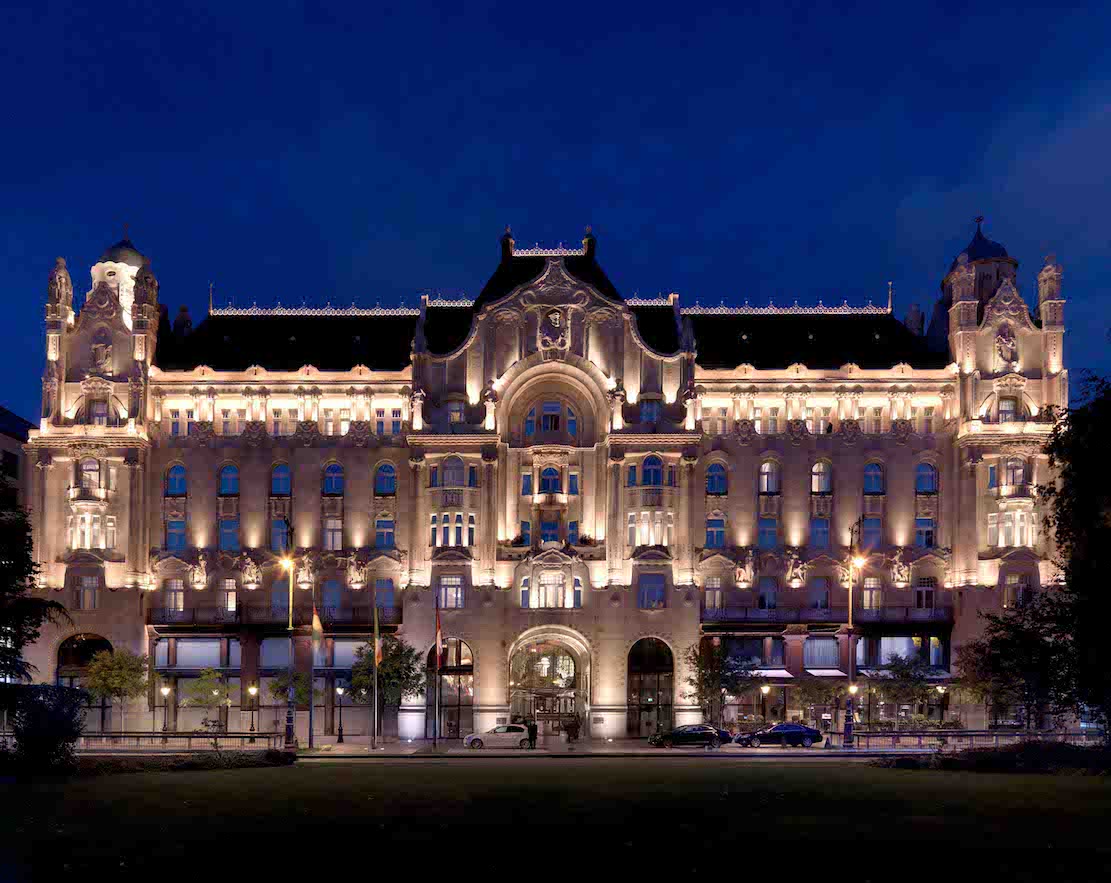 Today,
that façade (right)
has been restored to show all the magnificence
Lord Gresham (of
“Gresham’s Law”) intended, from its
ornately carved windows and stone sculptures and
its grand interior arcades with a glass dome hung
with a beehive-like crystal chandelier that lets
the soft Hungarian sun pour through.
Today,
that façade (right)
has been restored to show all the magnificence
Lord Gresham (of
“Gresham’s Law”) intended, from its
ornately carved windows and stone sculptures and
its grand interior arcades with a glass dome hung
with a beehive-like crystal chandelier that lets
the soft Hungarian sun pour through.
Kossuth Square expands away
from the river and is dominated by the great
Neo-Gothic Parliament building (below), 880
feet long and 315 feet tall, with a gilded dome
once topped in the post-war years with a red
Communist star, but that is long gone. The
building also houses a hall of Gobelin tapestries,
and a grand staircase decorated by Hungarian
masters like Károly Lotz and György Kiss.
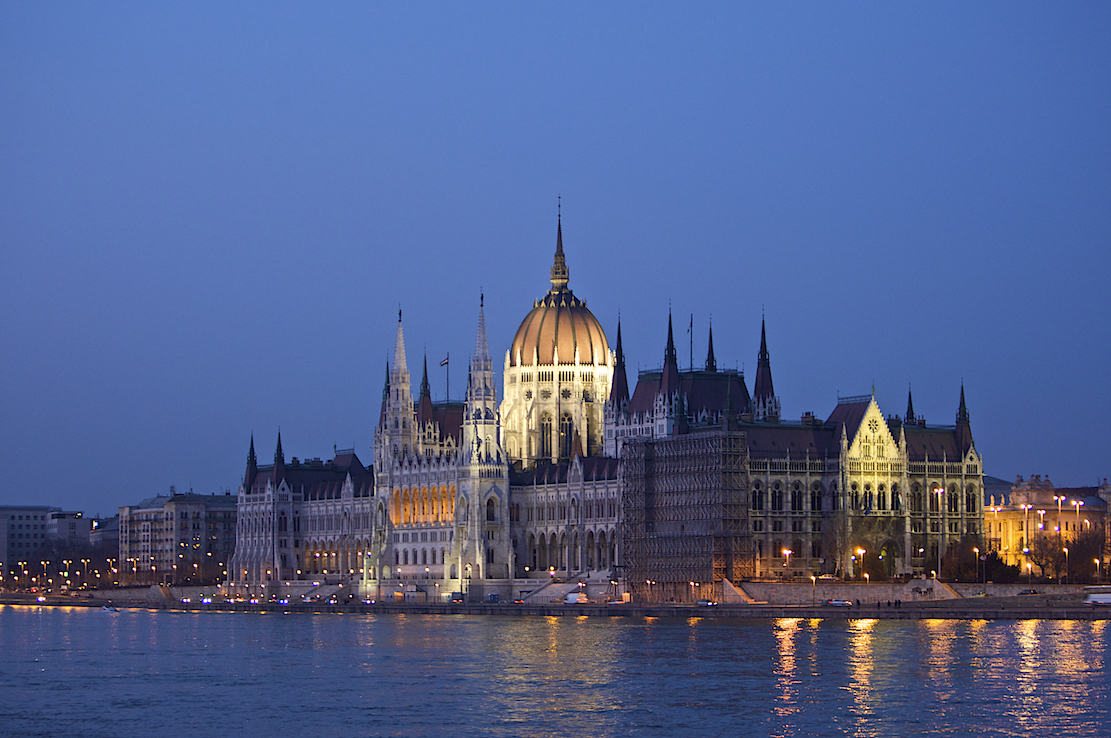 There
are so many neighborhoods and quarters being
gentrified throughout Budapest that, once a city
where one wandered aimlessly amidst shabby,
ill-lighted gray buildings, one now meanders
slowly to take in its unique cultural heritage
evident even in the back streets as much as on the
sweeping boulevards.
There
are so many neighborhoods and quarters being
gentrified throughout Budapest that, once a city
where one wandered aimlessly amidst shabby,
ill-lighted gray buildings, one now meanders
slowly to take in its unique cultural heritage
evident even in the back streets as much as on the
sweeping boulevards.
Indeed, in the past decade
Budapest has emerged as finer than it ever was,
ready to take its place again among Europe’s most
important modern metropolises. The
people move faster now, but slow down to eat and
drink better, and it is palpable in their manners
and greetings just how proud they are to welcome
visitors to a city that once was off limits to
much of the world.
❖❖❖
NEW YORK CORNER
By John Mariani
1662
3rd
Avenue (at
East 93rd Street)
646-964-5470
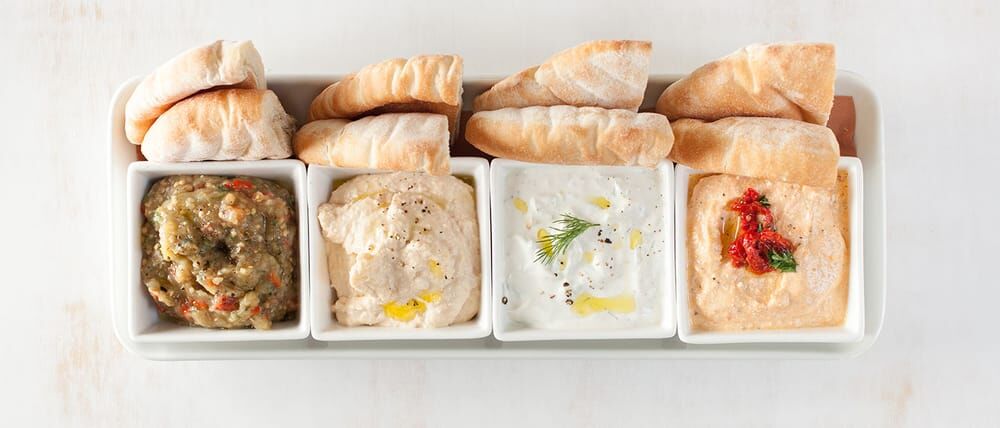
New York City has no dearth
of good Greek restaurants, from Milos, Molyvos
and Loi in Manhattan to a panoply (from the
Greek panoplia)
of them in Astoria, and most of them serve a
similar menu of traditional favorites, including
some of the best seafood anywhere.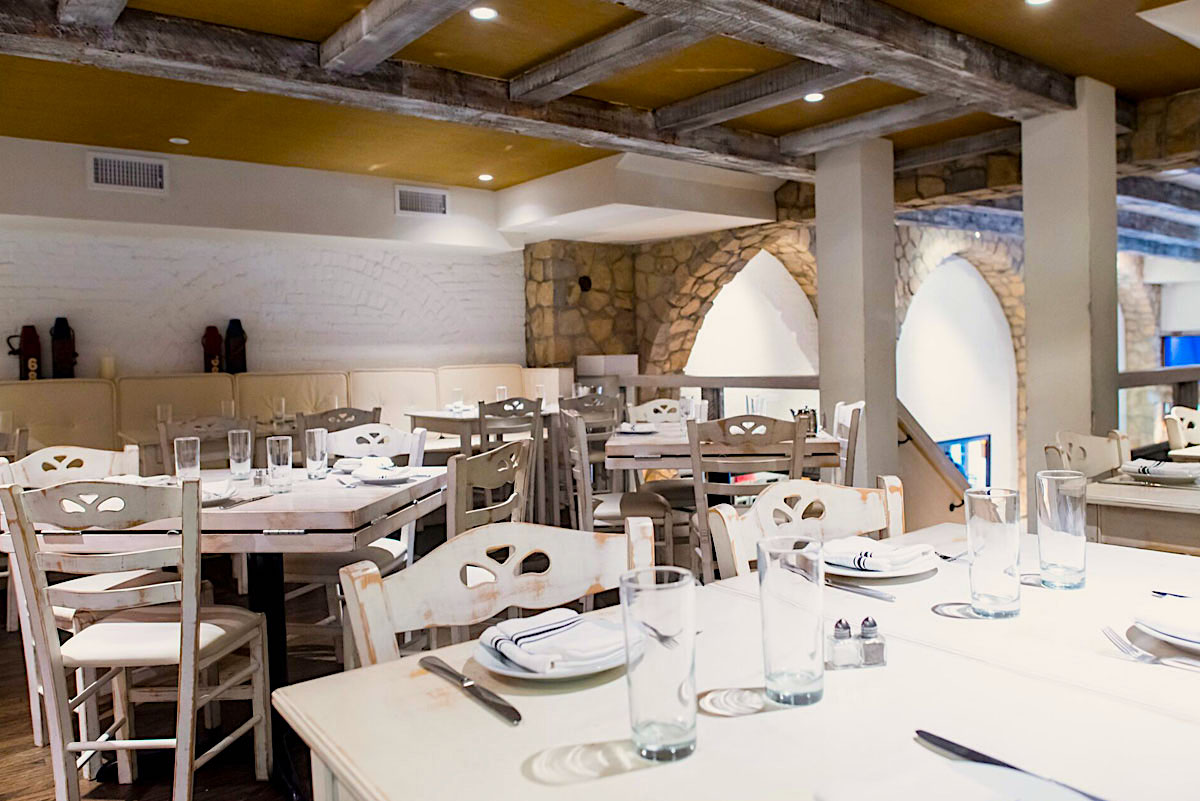
Korali Estiatorio, now opened
two years on the Upper East Side, where NYC food
media rarely stray, does not only serve superb
examples of those Greek classics but does it with
an open-armed hospitality within a cocoon-like
atmosphere that for me is the epitome of what a
comfortable restaurant should be. In other
restaurants you sit down; at Korali (Greek for
coral), you sink into the ambiance.
It’s not that the décor is all
that original—it draws heavily on the white and
Mediterranean blue of restaurants in the Greek
isles—but it’s how it’s all put together: The
two-level dining room and bar are perfectly
lighted to evoke conviviality, with high ceilings
and wooden and bamboo rafters, brick walls, stone
archways, and rustic white tables and chairs that
reflect the light—all an evocation of Mykonos as
transmuted by interior designer Yianni Skordas of
Skordas Design Studio.
Owner Gregori Politis is
everywhere to be seen in his restaurant, and it is
wise to put yourself in his hands, as our party of
four did. Otherwise
you may have an impossible time choosing among the
myriad salads and mezes on the menu. He sources
carefully, with sustainably raised organic meat
and seafood from Barn Lane Farms in Connecticut,
and his fish is as much as possible wild, not
farm-raised.
The wine list is much too short, perhaps a
problem of storage, but the selections are good
examples of modern Greek enology.
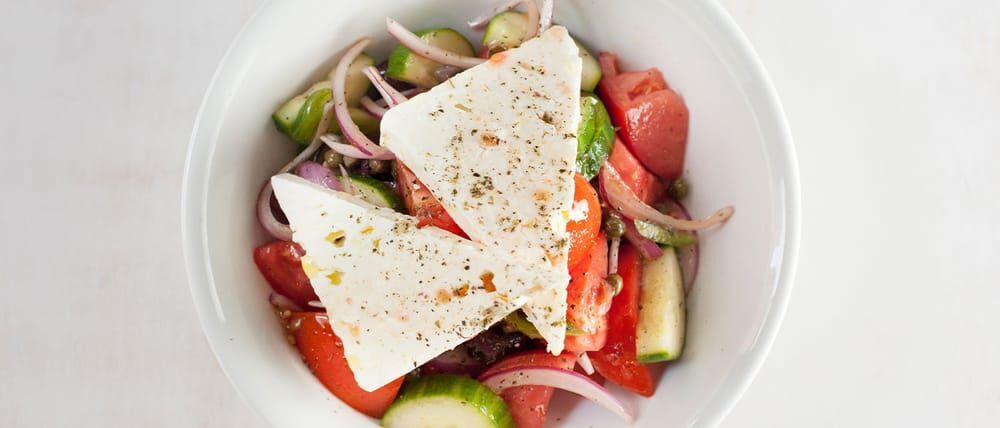 Good bread and Greek
olive oil are placed on the table and with the
variety of spreads ($6 each or $14 for four) you
get warm pita, though it is a rather flat,
listless version. Tzatziki,
marvelously thick Greek yogurt, is flecked with
cucumber, garlic and dill, and htipiti
is whipped spicy feta with a burst of roasted
chilies. Melitzanosalata
is a luscious, sweet-savory blend of roasted
eggplant, garlic, herbs and extra-virgin olive
oil.
Good bread and Greek
olive oil are placed on the table and with the
variety of spreads ($6 each or $14 for four) you
get warm pita, though it is a rather flat,
listless version. Tzatziki,
marvelously thick Greek yogurt, is flecked with
cucumber, garlic and dill, and htipiti
is whipped spicy feta with a burst of roasted
chilies. Melitzanosalata
is a luscious, sweet-savory blend of roasted
eggplant, garlic, herbs and extra-virgin olive
oil.
There is a big, generous Greek
salad ($12) that can serve two as an appetizer (left), and I
advise everyone to share the mezes like grilled
octopus with fava beans, pickled onions, cherry
tomatoes, capers and saffron-infused lemon oil ($18).
Kalamakia
are crispy calamari with garlic and rosemary and
tomato ($11), and fava Santorini is a delicious
yellow split pea purée with onions, capers,
parsley and olive oil ($9). Saganaki
comes as baked Greek cheese with a roasted
tomato compote ($12). 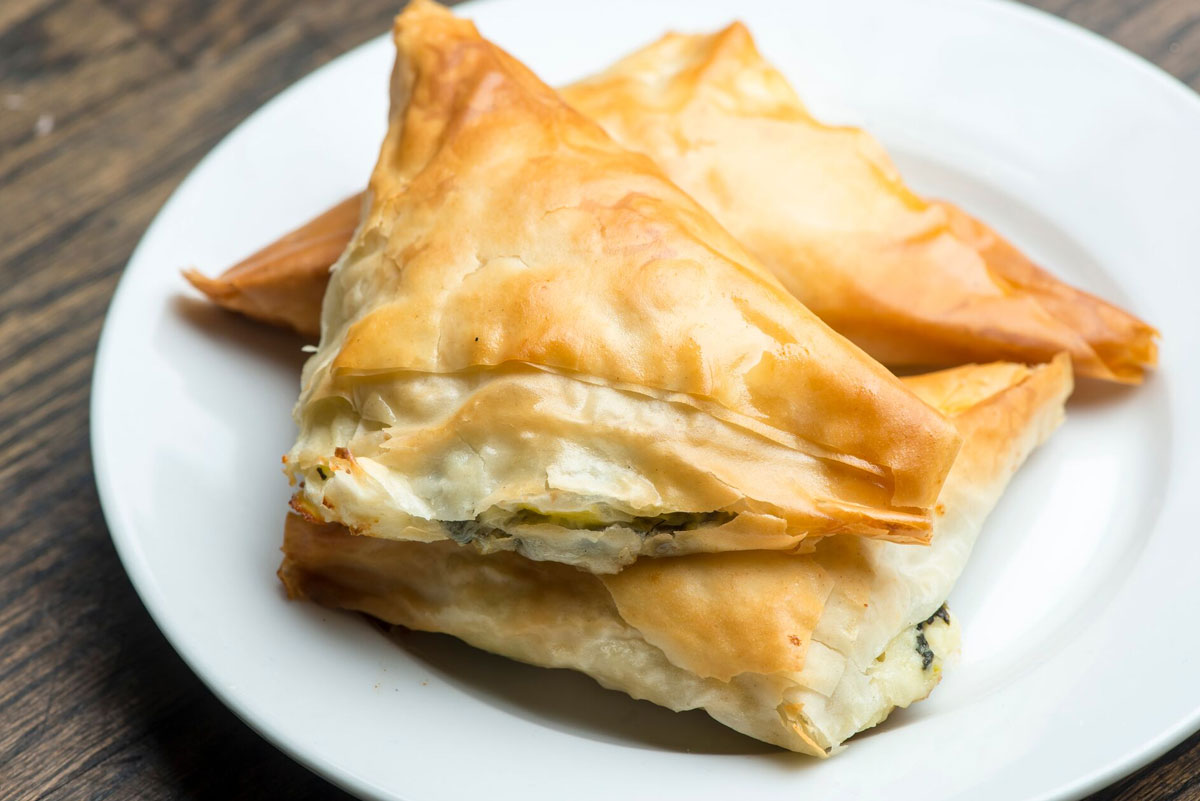
That all these and
more might compose an entire meal is tempting, but
you won’t want to miss Chef Peter Tsaglis’s main
courses, especially the perfectly grilled fish
like lavráki
(sea bass), whose flesh was moist and sweet,
barely touched with capers and olive oil (below), as
simple and wonderful as Greek food can be ($24). Next
time I’m going back for the prawns ($29)
or the xifias
souvlaki swordfish kebabs ($22).
Korali’s arni youvetsi
is a slowly braised lamb shank with sweet tomato,
orzo pasta and tangy feta cheese, easily a match
for the best Italian osso buco in NYC, and at a
very reasonable price ($22). Pastitsio,
usually made with ground meat, is done here as a
pasta dish, but I found it lacking in much
flavor.
The desserts are
well worth trying, from karidopita
($9), a delectable honey-soaked walnut cake to
housemade yogurt with a thick drizzle of thyme
honey ($9.50).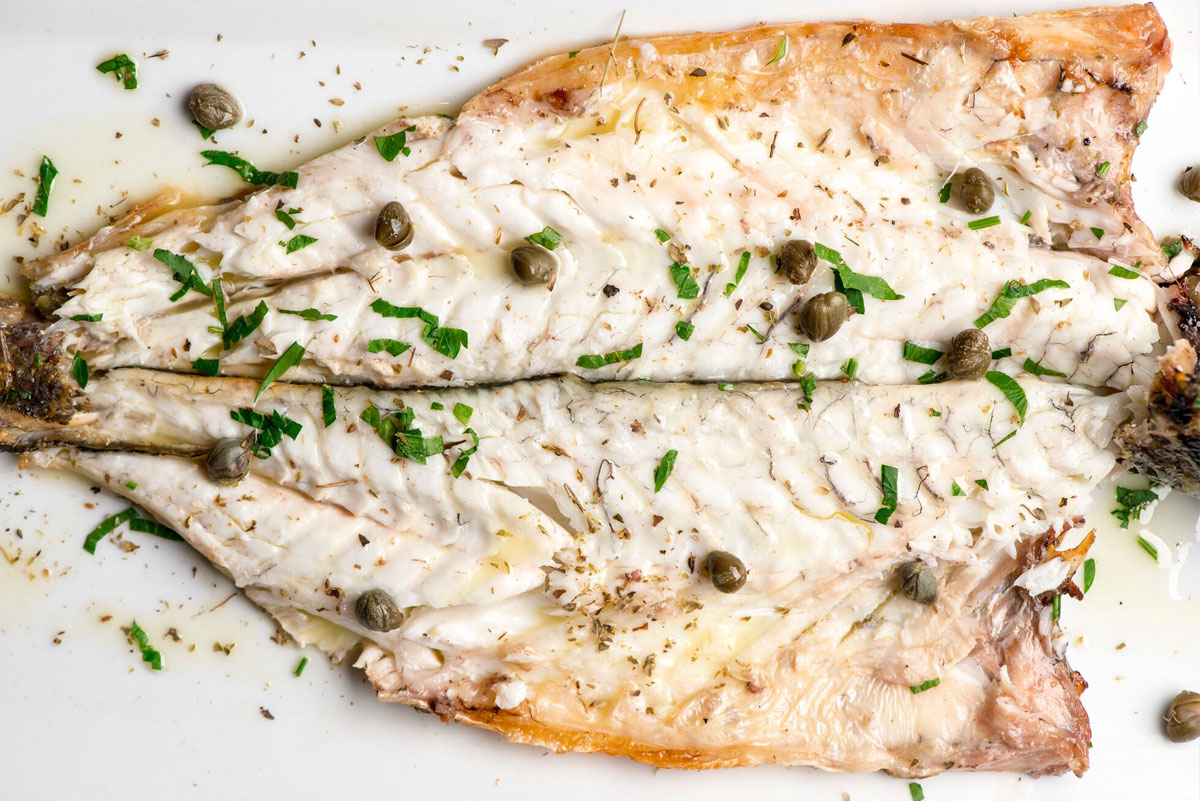
A semolina-wrapped
custard called galaktoboureco
with orange lemon zest syrup ($9) was good, though not
outstanding.
I’m told that guests
can also pre-order roasted whole goat sourced from
upstate New York that is wrapped in foil with
salt, pepper, olive oil and white wine and roasted
for three-and-a-half hours so that the meat almost
falls from the bone.
It is a cliché to say a
restaurant can transport you back to a favorite
place in another country, but in every detail
Gregori Politis has gotten Korali right, and
thereby serves as a marker for the best of Greek
cuisine and hospitality in NYC, whatever the
borough.
I read that the Greek
word efforia—euphoria—does
not mean an excited state of happiness as much as
it does good health. But if Polits opens another
restaurant in the future, he might well name it efforia and
take credit for any connotations it may express.
Korali is open for dinner nightly and offers a prix fixe lunch Wed.-Fri. and brunch on weekends.
By John A. Curtas

Twenty years ago, back when dead
tree journalism was still thriving, I attended a
convocation of food writers in Napa Valley. For
a few days, bigwigs from the New York
Times, Saveur and Bon Appetit
rubbed shoulders with food writers from around
the country.
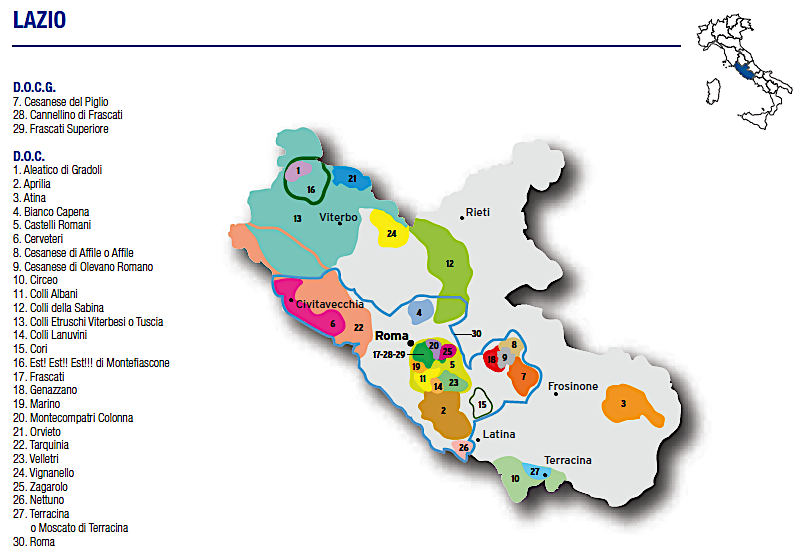 Among the
cookbook scribes, Marcella Hazan was the biggest
draw – commanding the main stage for her Italian
cooking demonstration. Her husband, Victor, did
the same as he lectured passionately about the
glories of Italian wine. After his talk (where he
was introduced as America's preeminent authority
on the subject), I asked him if there were any
books or guides to help me gain a better
understanding of Italian wine (or any
understanding of it for that matter). He responded
that he didn’t think so. Apparently, to learn
anything about Italian wine in America in 1997,
you had to know Victor Hazan.
Among the
cookbook scribes, Marcella Hazan was the biggest
draw – commanding the main stage for her Italian
cooking demonstration. Her husband, Victor, did
the same as he lectured passionately about the
glories of Italian wine. After his talk (where he
was introduced as America's preeminent authority
on the subject), I asked him if there were any
books or guides to help me gain a better
understanding of Italian wine (or any
understanding of it for that matter). He responded
that he didn’t think so. Apparently, to learn
anything about Italian wine in America in 1997,
you had to know Victor Hazan.
How things have
changed. Thanks to the tireless promotion
of Piero Selvaggio, John Mariani, Burton
Anderson, James Suckling and others (as well as
America's food revolution and the internet),
learning about Italian wines is much easier than
it used to be. But it's still a very dense and
difficult subject, even for the most ardent
oenophile. When you consider that Italy has twenty
different wine growing regions, producing wines
from hundreds of different grapes (over 350
authorized varieties at last count), the task is
daunting indeed. (By way of comparison, France
uses around 50 different grapes for its storied
wines.)
As
my Italian wine IQ grew (helped along by multiple
visits to Italy), one thing always puzzled me: for
a country 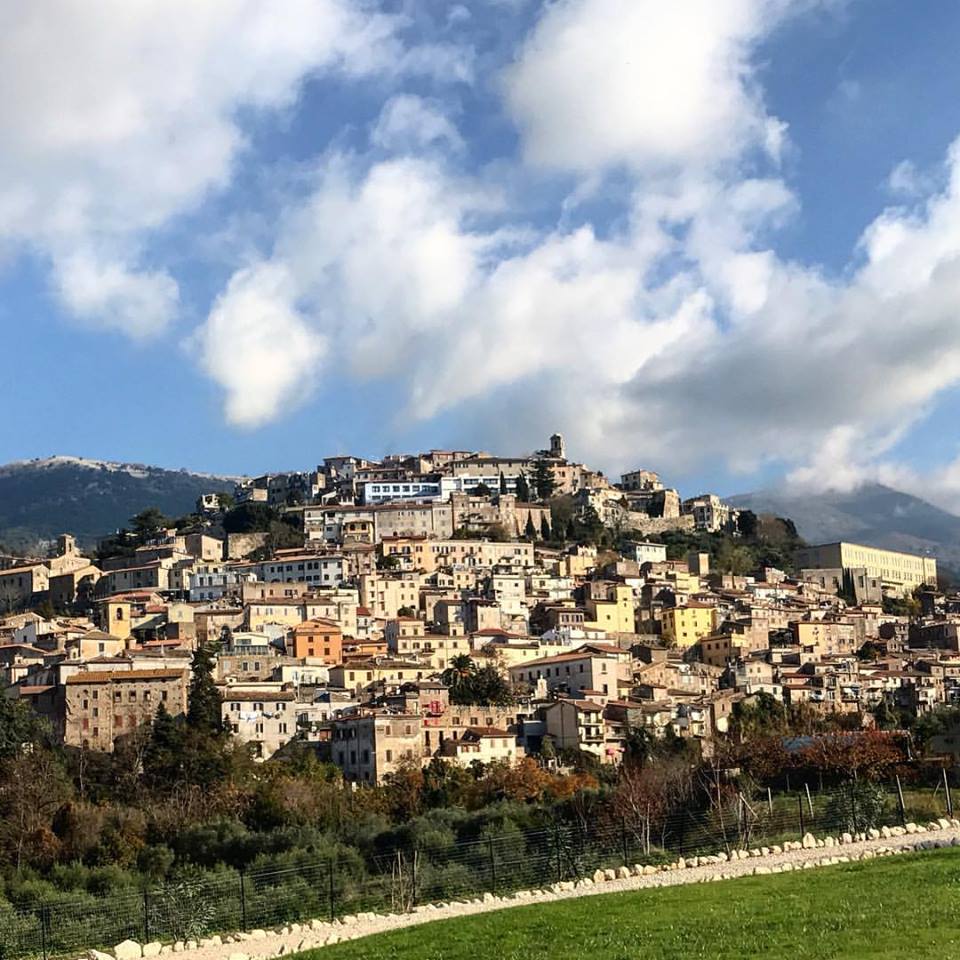 so rich in wine, no one
ever talks about Roman wines. While Roman
food may be renowned, its wines are rarely
mentioned in the same breath. Perhaps Roman wines
have suffered from an excess of Est!! Est!! Est!!
("The dullest white wine with the strangest name
in the world," says Jancis Robinson) and from the
oceans of cheap Frascati that fuel the trattorias
of the Eternal City. Between that reputation for
producing cheap,
uninteresting wine, and America's taste for the
killer “B’s”—Barolo, Barbaresco, and Brunello di
Montalcino—the flavorful and affordable wines
being made south of Rome have had an uphill climb
to gain the audience they deserve. But climb that
hill you should, and climb it I did to the town of
Cori (right),
to taste some well-crafted, intense and
fruit-forward juice that may finally put Roman
wines on the map.
so rich in wine, no one
ever talks about Roman wines. While Roman
food may be renowned, its wines are rarely
mentioned in the same breath. Perhaps Roman wines
have suffered from an excess of Est!! Est!! Est!!
("The dullest white wine with the strangest name
in the world," says Jancis Robinson) and from the
oceans of cheap Frascati that fuel the trattorias
of the Eternal City. Between that reputation for
producing cheap,
uninteresting wine, and America's taste for the
killer “B’s”—Barolo, Barbaresco, and Brunello di
Montalcino—the flavorful and affordable wines
being made south of Rome have had an uphill climb
to gain the audience they deserve. But climb that
hill you should, and climb it I did to the town of
Cori (right),
to taste some well-crafted, intense and
fruit-forward juice that may finally put Roman
wines on the map.
Marco Carpineti comes from
generations of winemakers, and since 1994 has been
making his own wines organically, and
bio-dynamically, using no herbicides, chemical
fertilizers or synthetic products. His winery is
set on a hillside on the road to Cori, just south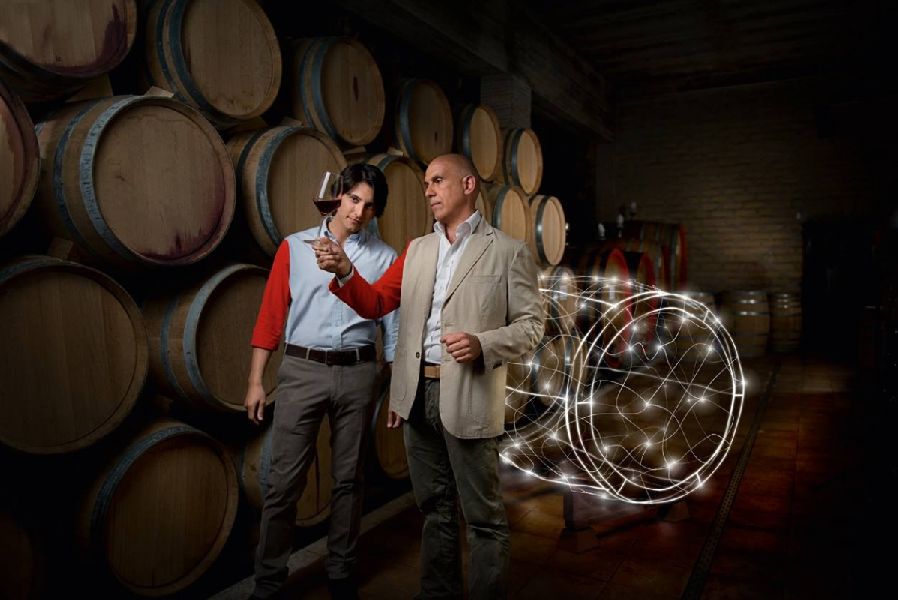 of Rome, which itself
sits more than 1,300 feet above sea level. His
vineyards are located on the hills and fields
below the mountain, and from these sites he crafts
a number of bewitching wines, most of which are
made with grapes you've never heard of.
of Rome, which itself
sits more than 1,300 feet above sea level. His
vineyards are located on the hills and fields
below the mountain, and from these sites he crafts
a number of bewitching wines, most of which are
made with grapes you've never heard of.
Bellone is one
such grape. A native vine that hints at the
herbaceousness of a good sauvignon blanc, with a
nice, round mouthfeel and lemony finish that makes
it perfect for seafood and oysters. If Carpineti
and other Lazio producers have their way, it is a
white wine that might someday challenge the
ubiquitous (and often boring) pinot grigio for
Italian white wine supremacy.
Whether
it does that or not, Carpineti certainly makes a
very firm and fresh sparkler called
Kius, which is every bit the equal of many a
prosecco. A step up in depth takes you to their
Kius Extra Brut (below), made
exclusively with Nero Buono di Cori grapes—a
well-balanced wine with a hint of fragiolini
(small strawberries) and brioche on the nose, 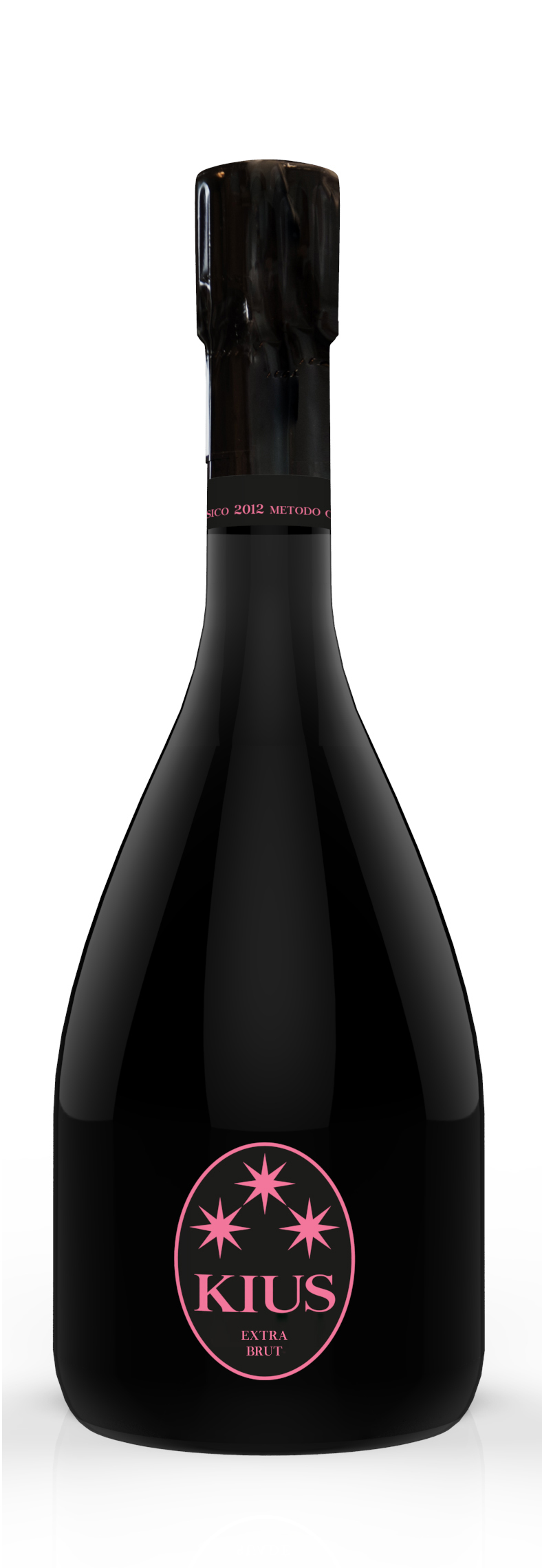 and a
long, medium dry finish. It starts slightly
sweet and floral on the tongue and ends dry, and
begs to be drunk with a variety of summer foods,
cured meats and mild cheeses.
and a
long, medium dry finish. It starts slightly
sweet and floral on the tongue and ends dry, and
begs to be drunk with a variety of summer foods,
cured meats and mild cheeses.
The Bellone grape makes another appearance
in Carpineti’s Capolemone white, which seeks to
harness the soil and scents of this native grape.
The light straw appearance is deceptive as the
wine is uncommonly round and full in mouth. It
finishes with hints of lemon, making it a perfect
accompaniment to grilled fish or fresh oysters.
Just as compelling is Moro, a blend
of white "Greco" grapes that yield a softer,
fruitier wine with hints of ripe fruit, perhaps
due to 30% of the grapes being fermented in
"refined oak barrels." The Moro struck me as an
excellent aperitif.
The sparklers and  white wines impressed us
the most at Carpineti, but it was their Tufaliccio
red blend of Montelpuciano and Cesanese grapes
that won the award for the hardest to pronounce,
easiest to drink wine of the day. This is a soft,
mellow, easy to gulp red that would go beautifully
with a variety of foods—sort of like a cru
Beaujolais, only earthier and without the latter's
high-toned fruit.
white wines impressed us
the most at Carpineti, but it was their Tufaliccio
red blend of Montelpuciano and Cesanese grapes
that won the award for the hardest to pronounce,
easiest to drink wine of the day. This is a soft,
mellow, easy to gulp red that would go beautifully
with a variety of foods—sort of like a cru
Beaujolais, only earthier and without the latter's
high-toned fruit.
Paolo Carpineti
couldn't have been a more gracious host, and to
cap off our day of tasting, he drove us to the top
of the town of Cori, where the Temple of Hercules
(left)
stands—built 300 years before the founding of
Rome. If you time your visit
right, as Paolo did for us, you will wind your way
to the top of this ancient town right at the end
of the day, where one of the most fabulous sunsets
in Italy awaits you.
Italian
wines, by their nature, are not wines for
dissection and introspection. They are as
indispensable a part to the enjoyment of an
Italian meal, as any pasta or protein. Italians
view wine as a food, and as something to be
enjoyed with food. This was the lesson of Cincinnato (below, left),
a cooperative wine maker a little down the hill
from Carpineti. Cincinnato is a winery, as well as
an agriturismo,
which means you can spend the night, sip, sup and
stay to your hearts content (as long as you book
one of their modern, comfortable rooms in
advance). It
is named after the famous Lucius Quinctius
Cincinnatus, a 5th Century BC Roman politician
who, rather than consolidating his power and
lording it over the country, went back to his farm
in the Cori countryside—as depicted by the logo.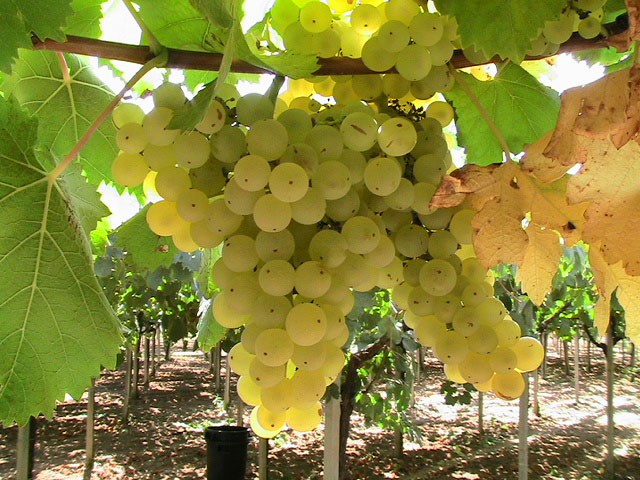
Bellone
grapes (right)
are cultivated in the lava hills around the Cori, and the
varietal has often been thought of as a simple or
blending wine. It may not have the structure of
more exalted grapes, but in Cincinnato's Castore
bottling there is nice acidity to go with its
silvery color and tart, faintly lemon peel-like
finish. In all, quite a mouthful for less than $15
retail.
From there, wine writer Charles
Scicolone and I worked our way through the entire
catalogue. (Wine tasting tip: If you're going to
tour Italian wineries, always be sure to bring
your very own Italian wine expert with you.) Both
of us liked the Castore, but we were more enamored
of the Pozzodorico Bellone, perhaps because it is
fermented and aged in wood for six months, giving
it more body and complexity and length than its
stainless steel cousin.
We then sampled
a fruit-forward blend of 50% Bellone, 30% Malvasia
del Lazio and 20% Greco—called Illirio Cori
Bianco—and a Pantaleo, made with 100% Greco
grapes. Our guide at the winery, Giovanna
Trisorio, described the Greco grape as an ancient,
indigenous variety that produces a soft, yet
full-bodied wine. I liked the Illirio's
minerality, but found it lighter, tighter and
tarter in the mouth than the much fuller Panteleo.
That both wines pack so much lip smacking
complexity in bottles costing around $10 is
something to behold.
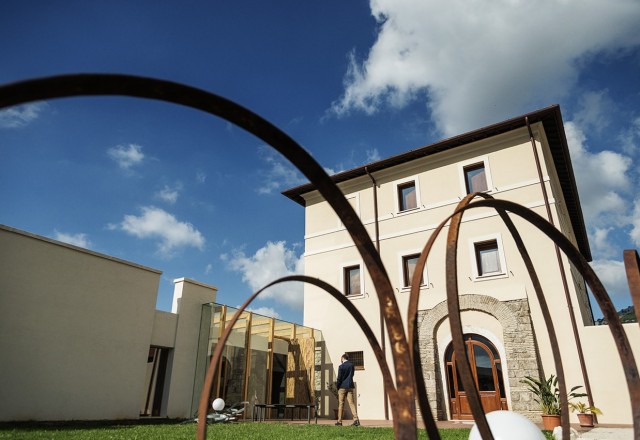 Of the reds we
tasted, the Polluce was the clear-cut
winner. Made with 100% Nero Buono grapes,
this was a fresh, smooth, easy-to-drink red. It
was dark purple in the glass and a touch
smoky—more redolent of black fruit than red—and
just the sort of vino rosso you'd want with some
beef cheek ravioli or spaghetti alla carbonara.
Of the reds we
tasted, the Polluce was the clear-cut
winner. Made with 100% Nero Buono grapes,
this was a fresh, smooth, easy-to-drink red. It
was dark purple in the glass and a touch
smoky—more redolent of black fruit than red—and
just the sort of vino rosso you'd want with some
beef cheek ravioli or spaghetti alla carbonara.
"All of these
wines need food," said Scicolone, and the winery
obliged, serving us a fantastic lunch of local
salumi, meats, cheeses and breads to accompany our
serious sipping, all accompanied by their
gorgeous, fresh, peppery olive oil.
Cincinnato represents more than
130 families, farmers and grape grower in the Cori
region. It has brought its wines into the 21st
Century with a sleek and stylish label that
announces some very approachable wines at
incredibly soft prices. Most of its catalogue
sells in America in the $10-$20 range, and for
that price you're getting some serious wine
making.
The
wines are named metaphorically (Castore and
Polluce are the twin brothers of Greek mythology
as well as characters in a famous Italian opera;
Illirio means "hill"), but they make it easy for
you by identifying the main grape variety right on
the front of the label. These varieties deserve to
be drunk more than they are on this side of the
pond, and after a few sips of Bellone, you may
never go back to mediocre pinot grigio again.
❖❖❖
MAKE THAT "THE ABSOLUTE MOST
ROMANTIC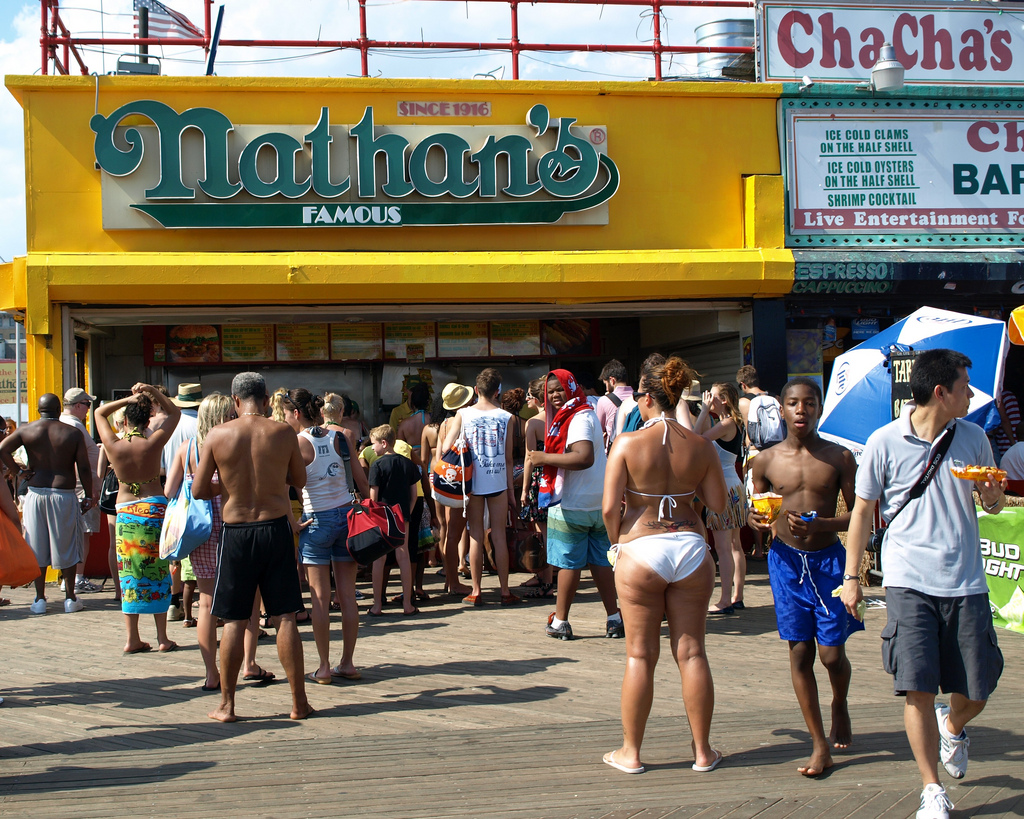
CHEAPSKATE
RESTAURANTS IN NEW YORK"
“Dumpling Galaxy: It’s much easier to find great food in Flushing than it is to find atmosphere, and though Dumpling Galaxy is technically in a shopping mall, it’s the rare establishment to offer both. There are plenty of sleek, semi-private-feeling booths to cozy into, and over 100 varieties of excellent dumplings to choose from — and what kind of person is not passionate about dumplings? . . . . Nathan’s Famous Hot Dogs: You can get a Nathan’s hot dog pretty much anywhere these days, and the branding lacks charm, but the original location, just steps from the boardwalk, still makes for one of the greatest cheap dates of all time.”--Hannah Goldfield, "The Absolute Best Romantic Restaurants in New York," New York Magazine (1/18/17).

THOU SHALT NOT TEXT
MESSAGE WHILE DINING
According
to The Local, Pope Francis
told a young crowd at a university in Rome that speaking
on the phone during dinner was going to ruin society.
"When we're at the table, when we are speaking to others
on our telephones, it's the start of war because there
is no dialogue," he said. The pope also told the crowd
that young people are too casual with their
manners, should take more care to be quieter, talk
less, and listen more to the people around them.
Any of John Mariani's books below may be ordered from amazon.com.
 The
Hound in Heaven (21st Century Lion Books)
is a novella, and for anyone who loves dogs,
Christmas, romance, inspiration, even the supernatural, I
hope you'll find this to be a treasured favorite.
The story concerns how, after a New England teacher,
his wife and their two daughters adopt a stray puppy found
in their barn in northern Maine, their lives seem full of
promise. But when tragedy strikes, their wonderful dog
Lazarus and the spirit of Christmas are the only things
that may bring his master back from the edge of
despair.
The
Hound in Heaven (21st Century Lion Books)
is a novella, and for anyone who loves dogs,
Christmas, romance, inspiration, even the supernatural, I
hope you'll find this to be a treasured favorite.
The story concerns how, after a New England teacher,
his wife and their two daughters adopt a stray puppy found
in their barn in northern Maine, their lives seem full of
promise. But when tragedy strikes, their wonderful dog
Lazarus and the spirit of Christmas are the only things
that may bring his master back from the edge of
despair. WATCH THE VIDEO!
“What a huge surprise turn this story took! I was completely stunned! I truly enjoyed this book and its message.” – Actress Ali MacGraw
“He had me at Page One. The amount of heart, human insight, soul searching, and deft literary strength that John Mariani pours into this airtight novella is vertigo-inducing. Perhaps ‘wow’ would be the best comment.” – James Dalessandro, author of Bohemian Heart and 1906.
“John Mariani’s Hound in Heaven starts with a well-painted portrayal of an American family, along with the requisite dog. A surprise event flips the action of the novel and captures us for a voyage leading to a hopeful and heart-warming message. A page turning, one sitting read, it’s the perfect antidote for the winter and promotion of holiday celebration.” – Ann Pearlman, author of The Christmas Cookie Club and A Gift for my Sister.
“John Mariani’s concise, achingly beautiful novella pulls a literary rabbit out of a hat – a mash-up of the cosmic and the intimate, the tragic and the heart-warming – a Christmas tale for all ages, and all faiths. Read it to your children, read it to yourself… but read it. Early and often. Highly recommended.” – Jay Bonansinga, New York Times bestselling author of Pinkerton’s War, The Sinking of The Eastland, and The Walking Dead: The Road To Woodbury.
“Amazing things happen when you open your heart to an animal. The Hound in Heaven delivers a powerful story of healing that is forged in the spiritual relationship between a man and his best friend. The book brings a message of hope that can enrich our images of family, love, and loss.” – Dr. Barbara Royal, author of The Royal Treatment.
 |
The Encyclopedia of American Food and Drink by John F. Mariani (Bloomsbury USA, $35) Modesty forbids me to praise my own new book, but let me proudly say that it is an extensive revision of the 4th edition that appeared more than a decade ago, before locavores, molecular cuisine, modernist cuisine, the Food Network and so much more, now included. Word origins have been completely updated, as have per capita consumption and production stats. Most important, for the first time since publication in the 1980s, the book includes more than 100 biographies of Americans who have changed the way we cook, eat and drink -- from Fannie Farmer and Julia Child to Robert Mondavi and Thomas Keller. "This book is amazing! It has entries for everything from `abalone' to `zwieback,' plus more than 500 recipes for classic American dishes and drinks."--Devra First, The Boston Globe. "Much needed in any kitchen library."--Bon Appetit. |
"Eating Italian will never be the same after reading John Mariani's entertaining and savory gastronomical history of the cuisine of Italy and how it won over appetites worldwide. . . . This book is such a tasteful narrative that it will literally make you hungry for Italian food and arouse your appetite for gastronomical history."--Don Oldenburg, USA Today. "Italian
restaurants--some good, some glitzy--far
outnumber their French rivals. Many of
these establishments are zestfully described
in How Italian Food Conquered the World, an
entertaining and fact-filled chronicle by
food-and-wine correspondent John F.
Mariani."--Aram Bakshian Jr., Wall Street
Journal.
"Equal parts
history, sociology, gastronomy, and just
plain fun, How Italian Food Conquered the
World tells the captivating and delicious
story of the (let's face it) everybody's
favorite cuisine with clarity, verve and
more than one surprise."--Colman Andrews,
editorial director of The Daily
Meal.com. "A fantastic and fascinating
read, covering everything from the influence
of Venice's spice trade to the impact of
Italian immigrants in America and the
evolution of alta cucina. This book will
serve as a terrific resource to anyone
interested in the real story of Italian
food."--Mary Ann Esposito, host of PBS-TV's
Ciao
Italia. "John Mariani has written the
definitive history of how Italians won their
way into our hearts, minds, and
stomachs. It's a story of pleasure over
pomp and taste over technique."--Danny Meyer,
owner of NYC restaurants Union Square
Cafe, The Modern, and Maialino.
|
 |
 |
 |
 |
 |
 |
 |
 |
 Everett Potter's Travel Report:
Everett Potter's Travel Report: 
 Eating Las Vegas
JOHN CURTAS has been covering the Las Vegas
food and restaurant scene since 1995. He is
the co-author of EATING LAS VEGAS – The 50
Essential Restaurants, as well as
the author of the Eating Las Vegas web site: www.eatinglasvegas.
He can also be seen every Friday morning as
the “resident foodie” for Wake Up With the
Wagners on KSNV TV (NBC) Channel 3 in
Las Vegas.
Eating Las Vegas
JOHN CURTAS has been covering the Las Vegas
food and restaurant scene since 1995. He is
the co-author of EATING LAS VEGAS – The 50
Essential Restaurants, as well as
the author of the Eating Las Vegas web site: www.eatinglasvegas.
He can also be seen every Friday morning as
the “resident foodie” for Wake Up With the
Wagners on KSNV TV (NBC) Channel 3 in
Las Vegas.

MARIANI'S VIRTUAL GOURMET
NEWSLETTER is published weekly. Editor/Publisher: John
Mariani.
Editor: Walter Bagley. Contributing Writers: Christopher Mariani,
Robert Mariani, Misha Mariani, John A. Curtas, Geoff Kalish, Mort
Hochstein, and
Brian Freedman. Contributing Photographers: Galina
Dargery. Technical Advisor: Gerry McLoughlin.
To un-subscribe from this newsletter,click here.
© copyright John Mariani 2017

